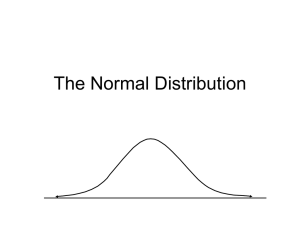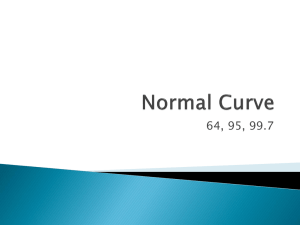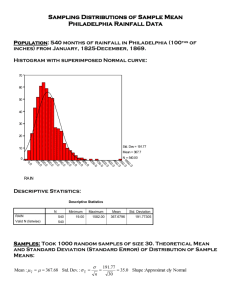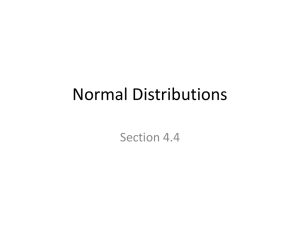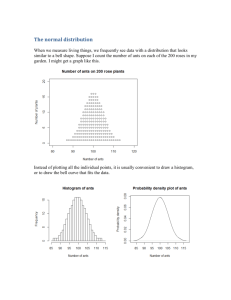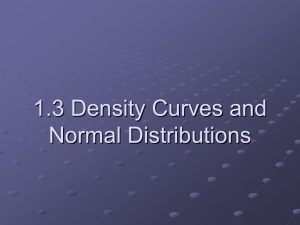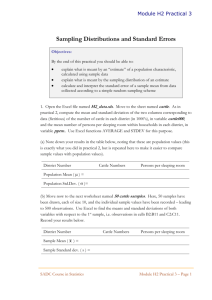CHAPTER 4 Basic Probability and Discrete Probability Distributions
advertisement
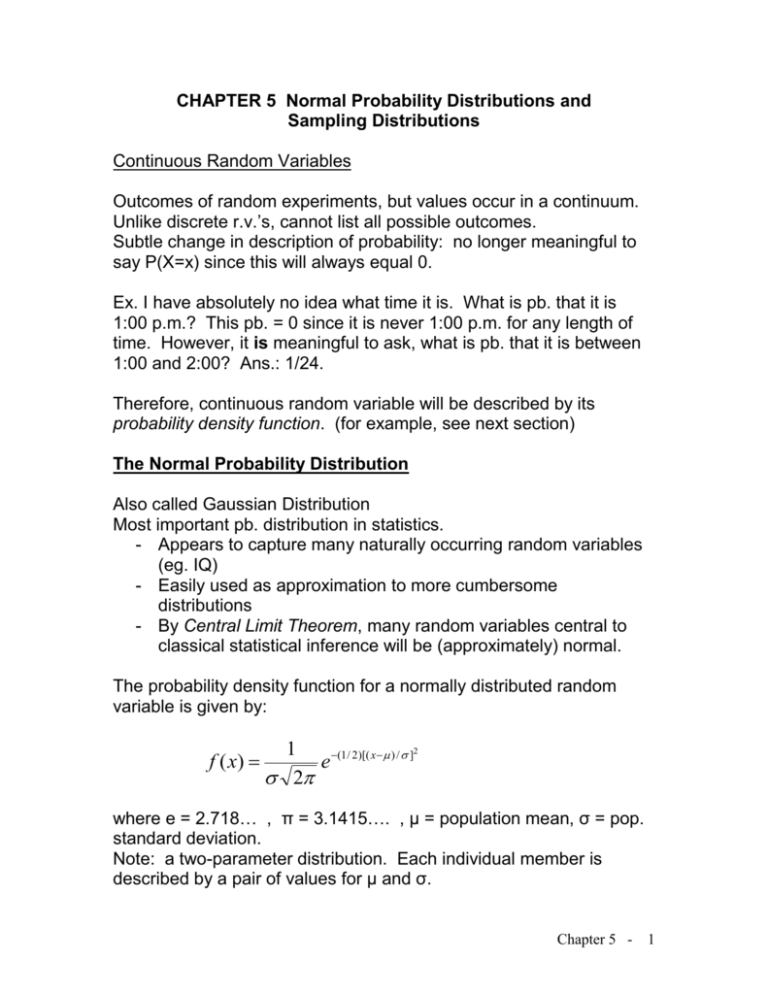
CHAPTER 5 Normal Probability Distributions and Sampling Distributions Continuous Random Variables Outcomes of random experiments, but values occur in a continuum. Unlike discrete r.v.’s, cannot list all possible outcomes. Subtle change in description of probability: no longer meaningful to say P(X=x) since this will always equal 0. Ex. I have absolutely no idea what time it is. What is pb. that it is 1:00 p.m.? This pb. = 0 since it is never 1:00 p.m. for any length of time. However, it is meaningful to ask, what is pb. that it is between 1:00 and 2:00? Ans.: 1/24. Therefore, continuous random variable will be described by its probability density function. (for example, see next section) The Normal Probability Distribution Also called Gaussian Distribution Most important pb. distribution in statistics. - Appears to capture many naturally occurring random variables (eg. IQ) - Easily used as approximation to more cumbersome distributions - By Central Limit Theorem, many random variables central to classical statistical inference will be (approximately) normal. The probability density function for a normally distributed random variable is given by: f ( x) 2 1 e (1/ 2)[( x ) / ] 2 where e = 2.718… , π = 3.1415…. , μ = population mean, σ = pop. standard deviation. Note: a two-parameter distribution. Each individual member is described by a pair of values for μ and σ. Chapter 5 - 1 Appears complex, but f(x) simply defines a function. This function will always: 1. 2. 3. 4. 5. be bell-shaped and perfectly symmetrical about the mean have same values for mean, median, and mode have a range of values from minus to plus infinity have an area under the curve equal to 1 have c. 68% of the area within 1 std. dev. of the mean, 95% within 2 std. dev.’s, and 99% within 3 std.dev.’s. Changing μ shifts the curve horizontally, changing σ collapses or expands the distribution about the mean. Ex. μ determines where the midpoint of the distribution falls. Changes in μ , without changes in σ , result in moving the distribution to the right or left, depending upon whether the new value of μ was larger or smaller than the previous value, but does not change the shape of the distribution. An example of how changes in μ affect the normal curve are presented below: Changes in the value of σ, on the other hand, change the shape of the distribution without affecting the midpoint, because d affects the spread or the dispersion of scores. The larger the value of σ , the more dispersed the scores; the smaller the value, the less dispersed. Perhaps the easiest way to understand how σ affects the distribution is graphically. The distribution below demonstrates the effect of increasing the value of σ : Chapter 5 - 2 Note that the shape of the second distribution has changed dramatically, being much flatter than the original distribution. It must not be as high as the original distribution because the total area under the curve must be constant, that is, 1.00. The second curve is still a normal curve; it is simply drawn on a different scale on the X-axis. If X is a normally distributed random variable, this is denoted by X ~ N(μ,σ2) The Standard Normal Density Function: z There are an infinite number of normal r.v.’s (one for each combination of μ and σ. A special member of the normal class is found when μ = 0 and σ = 1. Given the notation z: z ~ N(0,1) is the standard normal random variable. This is the ONLY member of the normal family for which textbooks report probabilities. Refer to a standard normal distribution table. In our textbook, Table E.2 provides area under density function below the stated values of z, where z is available up to 2 decimal places. Ex. P(z < 1.35) = P(z ≤ 1.35) = 0.9115 Note: care should be exercised if using other texts. Most texts report area between z = 0 and required value of z; i.e., P(0 < z < 1.35) = 0.4115. Easy to calculate P(z < 1.35) since we know P(z < 0) = .5. Add this to 0.4115. Chapter 5 - 3 How to calculate P(z>1.35)? Use the fact that area under density function must equal 1. Then P(z>1.35) = 1 – P(z<1.35) = 1 – 0.9115 = 0.0885. Note that this is same as P(z<-1.35) : z density function is symmetric. When finding pb.’s, always draw a picture. Ex. Find P(-0.45 < z < 1.96) = P(z<1.96) – P(z<-0.45) = 0.9750 – 0.3264 = 0.6486. Some special cases P(-1 < z < 1) = P(z < 1) – P(z < -1) = 0.8413 – 0.1587 = 0.6826 P(-2 < z < 2) = P(z < 2) – P(z < -2) = 0.9772 – 0.0228 = 0.9544 P(-3 < z < 3) = P(z < 3) – P(z < -3) = 0.9987 – 0.0014 = 0.9973 Basis for empirical rule (or, normal approximation rule) used to interpret values of standard deviation. Finding pb.’s for other normal random variables Texts cannot produce tables for all possible normal random variables. Not necessary. Suppose X ~ N(μ,σ2). Compute a new random variable by subtracting μ and dividing by σ. This new random variable will be standard normal. i.e. (X - μ)/ σ ~ N(0,1) ~ z. Ex. Suppose X ~ N(24, 32). Then (X-24)/3 ~ N(0,1). Find P(X<19). P( x 19) P( x 19 24 ) P( z 1.67) 0.0475 3 Simple intuition. The value 19 lies 1.67 standard deviations below the mean of 24. The pb. that this random variable X takes a value below 19 is the same as the pb. that any normally distributed random variable takes a value more than 1.67 standard deviations below the Chapter 5 - 4 mean. We can use z table to calculate this. -1.67 is 1.67 standard deviations below its mean. NOTE: Excel can calculate any normal pb. using NORMDIST( ). Ex. A battery manufacturer produces a battery pack that will power an electric car at 90 kmh for an average of 8 hours. There is variability in the life of these packs. Data shows that lives of packs is normally distributed with mean 8 hrs. and standard deviation of 0.4 hours. X ~ N(8, 0.42). Consumers require reliability and company is concerned that market will disappear if too many consumers find a battery life of less than 7.5 hours. What are the chances that this will happen (i.e., what proportion of batteries will last less than 7.5 hours)? P( x 7.5) P( x 7.5 8 ) P( z 1.25) 0.1056 0.4 N.B.: Always subtract mean from x in the correct order. The negative sign on -1.25 is VERY meaningful. Suppose this risk is unacceptable and that maximum risk that life is less than 7.5 hours is 2%. How much would the mean life expectancy have to be increased to lower risk to this level, assuming standard deviation is unchanged at 0.4 hours? Find z* so that P(z < z*) = 0.02. From z table, required z* = -2.06. Then mean must lie 2.06 standard deviations above 7.5. Required mean is 7.5 + 2.06(0.4) = 8.32 hours. Ex. Fast food chain finds that amount of time spent by customers from entering the parking lot to receiving their food order is normally distributed with μ = 22.14 minutes and σ = 6.09 minutes. Considers providing free meals to any customer having to wait more than 30 minutes. What is the pb. of having to provide a free meal? X ~ N(22.14, 6.092) Chapter 5 - 5 P ( X 30 ) P ( x 30 22.14 ) P ( z 1.29 ) P ( z 1.29 ) .0985 6.09 Therefore, 9.85% of customers will be provided a free meal. This pb. can be lowered to 5% by providing free meal to customers waiting more than 32 minutes. Finding Values of X Corresponding to Known Probability What is value of z that leaves 90% of pb. below it? I.e., find z* so that P(z<z*)=0.9 Use table entries to find, z* = 1.28. Now suppose test scores in a population are normally distributed with X ~ N(137, 17.22). What is the test score such that 90% of the population scores less than this score? Find X* such that P(X < X*) = 0.90. We know that the required value is 1.28 standard deviations above the mean, so X* = 137 + (1.28)(17.2) = 159.02 This is the 90th percentile. Ex. If x ~ N(60,102), find X* so that 90% of pb. lies within the range μ – X* and μ + X*. Step 1: What is z* so that P(μ – z* < z < μ + z*). Find z* so that P(0 < z < μ + z*) = 0.45 z* = 1.645 Step 2: Calculate X* as the value lying 1.645 standard deviations above and below the mean; 60 – (10)(1.645) = 43.55 60 + (10)(1.645) = 76.45. Therefore, 90% of pb. is between 43.55 and 76.45. Chapter 5 - 6 Example of use of normal distribution A set of final examination grades in a statistics course was found to be normally distributed with a mean of 73 and a standard deviation of 8. a. What is the pb. that a randomly selected grade is 91% or less? Construct picture. P(X ≤ 91) = P((x-μ)/σ < (91-73)/8) = P(z < 2.25) = 0.9878. Intuitively, 91 is 2.25 std. dev.’s above the mean. b. What percentage of students scored between 65 and 89? Construct picture. 65 73 x 89 73 ) P ( 1 z 2 ) 8 8 P ( z 2 ) P ( z 1) 0.9772 0.1587 0.8185 P ( 65 x 89 ) P ( c. What is the grade such that only 5% of students achieved a higher grade than this? Construct picture. We need a grade that leaves 5% of the area above that value. What value of z leaves 5% above? The same value that leaves 95% below. Search standard normal table for a cell containing 0.9500. Use 1.645. Therefore, the grade required lies 1.645 standard deviations above the mean. Only 5% of students achieved a grade higher than 73 + (1.645)(8) = 86.16% d. If the professor grades on a curve and gives A’s to the top 10% of the class regardless of the actual grades, is a student better off with a grade of 81 on this exam or a grade of 68 on a different exam where the mean is 62 and the std. dev. is 3? Chapter 5 - 7 On this exam, is 81% in the top 10% of the grades? Draw the picture. 81% is (81-73)/8 = 1 standard deviation above the mean. Therefore 84.13% of the class scored 81% or less and the student is not in the top 10%. On the other exam, 68% is (68-62)/3 = 2 standard deviations above the mean. Therefore 97.72% of students scored 68% or less and the grade of 68% is in the top 10%. Therefore, the second situation is better. Chapter 5 - 8
